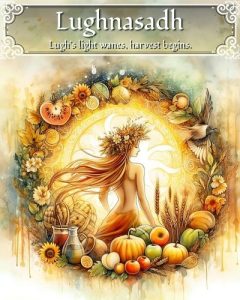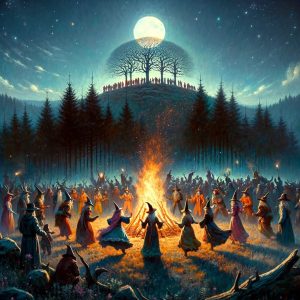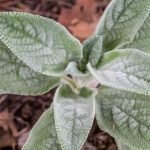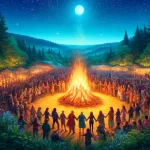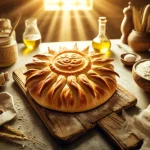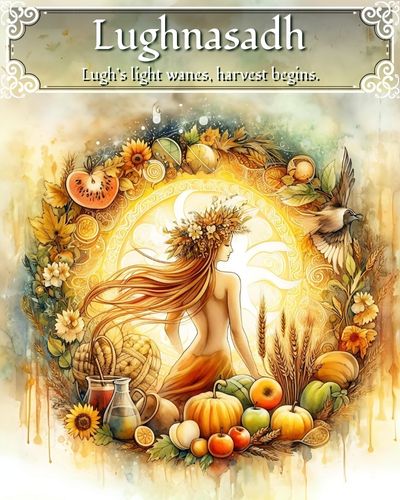
Approx. Reading time: About 17 Minutes

Introduction
Lughnasadh: Celebrating the First Harvest
Lughnasadh is a significant festival in the Wheel of the Year celebrated by various pagan and Celtic-inspired traditions. As the first harvest festival, it marks the transition from summer to autumn and honors the bounty of the earth. In this article, we will explore the origins, traditions, and customs associated with Lughnasadh, as well as provide guidance on how to practice this sacred festival while prioritizing safety.

What is Lughnasadh?
Lughnasadh is a Gaelic festival that holds great significance in Celtic traditions and pagan practices. Derived from the name of the Celtic god Lugh, who is revered as a deity associated with skill, craftsmanship, and harvest, Lughnasadh celebrates the beginning of the harvest season. This festival typically takes place on August 1st or the first weekend of August in the Northern Hemisphere, aligning with the ripening of crops and the abundance of nature.
Lughnasadh holds deep agricultural and spiritual roots, serving as a time to express gratitude for the bountiful yields of the land. It marks the moment when the first crops, especially grains like wheat and barley, are gathered from the fields. The festival acknowledges the hard work and skill of the farmers who have labored throughout the year to cultivate and nurture the land. It is a joyous celebration of the earth’s fertility and the life-sustaining sustenance it provides.
Beyond the agricultural aspect, Lughnasadh also carries profound symbolism related to the cycle of life, death, and rebirth. As the first harvest festival, it represents the culmination of growth and the transition from summer to autumn. It serves as a reminder of the interconnectedness between nature’s cycles and our own lives, highlighting the importance of embracing change, acknowledging the impermanence of all things, and finding renewal in every ending.
Lughnasadh is a time of reverence for the earth’s abundance, a moment to honor the interconnected web of life and express gratitude for the sustenance it bestows upon us. It is a celebration that invites us to connect with the rhythms of nature, to recognize our role as stewards of the land, and to reflect on the profound cycles of growth and renewal that permeate our existence.
History and Origin:
Lughnasadh has a rich history rooted in ancient Celtic mythology and culture. This festival is closely tied to the legendary tale of Lugh’s foster mother, Tailtiu, and her significant role in the development of agriculture in Ireland. According to the myth, Tailtiu, a goddess associated with fertility and the land, tirelessly cleared the plains of Ireland, making way for agricultural practices and the cultivation of crops.
Tragically, Tailtiu’s efforts took a toll on her, and she eventually succumbed to exhaustion and passed away. In honor of her immense sacrifice and dedication, Lugh, the god of light and skill, established the festival of Lughnasadh as a commemoration of Tailtiu’s contributions and a celebration of the harvest season.
Lughnasadh was widely observed throughout ancient Ireland, Scotland, and other Celtic regions. It held a significant place in the hearts of communities, who eagerly awaited the festival as a time of coming together, merriment, and reverence for the earth’s abundant gifts. The festival served as a communal celebration, where people would gather for feasting, engaging in lively games and competitions, and participating in various religious ceremonies.
The ancient Celts recognized Lughnasadh as an occasion to express gratitude for the bountiful harvest and to honor the cyclical nature of life and the agricultural cycle. It was a time to celebrate the fruits of their labor, to give thanks for the nourishment provided by the land, and to invoke blessings for continued abundance in the coming year.
The traditions and rituals associated with Lughnasadh varied across different Celtic regions, but the core themes of honoring the harvest, paying homage to Tailtiu’s legacy, and fostering a sense of community and connection with nature remained consistent. Today, these ancient customs continue to inspire modern celebrations of Lughnasadh, as people embrace the spirit of gratitude, abundance, and interconnectedness with the natural world.
Traditions and Customs:
Lughnasadh, the Celtic festival of the first harvest, is steeped in age-old traditions and customs that reflect the deep reverence for the land and the cycles of nature. These practices have been passed down through generations, embodying the spirit of community, gratitude, and celebration. From feasting on seasonal foods to engaging in playful competitions and participating in sacred rituals, the traditions of Lughnasadh offer a profound connection to our agricultural roots and an opportunity to honor the abundance bestowed upon us by the Earth. Let us explore some of the cherished customs that continue to be observed during this special time of the year. Lughnasadh is marked by a variety of traditions and customs that have been passed down through generations.
Common practices include:
Harvest Offerings: Abundance and Fertility of the Earth
One of the central traditions during Lughnasadh is the practice of making harvest offerings. As a celebration of the bountiful harvest season, people gather the first fruits, grains, or baked goods from their fields and gardens as a token of gratitude to the land and the deities associated with Lughnasadh. These offerings symbolize the abundance and fertility of the Earth, acknowledging the vital role it plays in sustaining life.
The harvest offerings can take various forms, depending on personal preference and regional customs. Some may choose to create beautiful displays on their altars, arranging the freshly harvested produce in a visually appealing manner. Others may share the offerings with family, friends, or neighbors, fostering a sense of communal sharing and appreciation. It is also common for individuals to donate a portion of their harvest to those in need, recognizing the importance of generosity and compassion during this season of plenty.
The act of making harvest offerings is not only a way to honor the agricultural abundance but also a way to express gratitude for the sustenance and nourishment provided by the land. It serves as a reminder of our interconnectedness with nature and our reliance on the cycles of growth and harvest. By participating in this tradition, individuals connect with the ancient rhythms of the Earth and express their reverence for the gifts it bestows upon us.
Corn Dollies: Symbolizing Harvest Spirit and Fertility
A beloved tradition associated with Lughnasadh is the creation of corn dollies or straw figures. These intricate and beautiful crafts serve as powerful symbols of the harvest spirit and the fertility of the land. Typically made from the stalks of wheat or corn, corn dollies are woven or braided into various shapes and designs that reflect the creativity and skill of the artisans.
The art of making corn dollies dates back centuries and was practiced in many agricultural communities. It was believed that the spirit of the harvest resided within the last sheaf of wheat or the final ears of corn, and by fashioning these materials into a doll-like form, the essence of the harvest was preserved and honored. The corn dolly was seen as a protective charm, representing the life force that sustained the crops and ensured a prosperous harvest for the coming year.
During Lughnasadh celebrations, corn dollies are often prominently displayed in homes or hung in doorways and windows. They serve as a reminder of the abundance and blessings bestowed upon the community by the land. It is believed that these straw figures attract positive energy, fertility, and good fortune, safeguarding the household and its inhabitants.
Creating corn dollies is not only a celebration of craftsmanship and creativity but also a way to connect with the agricultural heritage and express gratitude for the cycle of life and abundance. The act of weaving or braiding the straw stalks is often done in a communal setting, fostering a sense of unity and shared purpose. By engaging in this traditional practice, individuals honor the sacred connection between humanity and the natural world, paying homage to the transformative power of the harvest.
Games and Competitions: Celebrating Skills and Community
Lughnasadh, inspired by the legendary skills of the Celtic god Lugh, is a time for celebrating talents and fostering community connections through spirited games and competitions. In ancient times, sporting events and contests were an integral part of Lughnasadh festivities, creating a joyful and competitive atmosphere that brought people together.
Races: Swift and Agile
Races were a popular feature of Lughnasadh celebrations, with participants showcasing their swiftness and agility. Foot races, horse races, and even chariot races were organized to test the physical prowess of the participants. These races not only provided entertainment but also served as a reminder of the importance of speed and stamina in agricultural pursuits, where swift action and efficient movement were crucial during the harvest season.
Archery: Marksmanship and Precision
Archery contests were another common highlight of Lughnasadh. Participants would demonstrate their marksmanship and precision with a bow and arrow, symbolizing the skills necessary for hunting and protecting the community. These competitions not only showcased individual talent but also fostered a sense of camaraderie and shared appreciation for the art of archery.
Storytelling: Power of Words
Storytelling contests were a cherished tradition during Lughnasadh, celebrating the power of words and the oral traditions of the Celtic culture. Bards and storytellers would captivate audiences with their tales of heroes, myths, and legends, enchanting listeners with their storytelling abilities. These contests not only entertained the community but also preserved the rich cultural heritage and passed down wisdom from generation to generation.
Engaging in games and competitions during Lughnasadh is a way to honor the spirit of Lugh and celebrate the diverse talents and skills within the community. These activities foster a sense of unity, friendly competition, and shared joy, bringing people closer together as they participate in the festivities. By engaging in these traditions, individuals connect with their cultural roots, honor the legacy of Lugh, and strengthen the bonds of community.
The Feast of Plenty: Sharing Abundance and Nourishment
At the heart of Lughnasadh celebrations lies the Feast of Plenty, a cherished tradition that brings loved ones together to share in the abundance of the harvest. This feast, marked by an array of delectable foods, reflects gratitude for the fruitful yields of the land and the blessings bestowed upon the community. It is a time to gather, nourish both body and spirit, and celebrate the generosity of the Earth.
Baked Bread!
Freshly baked bread takes center stage at the Feast of Plenty, symbolizing the importance of the harvest’s first grains. Breadmaking holds deep significance during Lughnasadh, as it represents the transformation of the harvested wheat or barley into sustenance. Families and communities come together to knead dough, shape loaves, and savor the aroma of freshly baked bread, connecting with the ancient traditions that honor the life-giving properties of the grain.
Fruits and Vegetables!
Seasonal fruits and vegetables grace the tables, showcasing the vibrant colors and flavors of the summer harvest. From succulent berries and juicy melons to crisp greens and garden-fresh vegetables, these seasonal offerings symbolize the nourishment provided by nature during this abundant time of year. Incorporating these seasonal delights into the feast not only adds a delightful variety to the menu but also highlights the connection between the land and the sustenance it provides.
Gathered Crops
Dishes made from the first harvest take pride of place during the Feast of Plenty. Featuring freshly gathered crops, such as corn, beans, peas, and root vegetables, honor the labor of the farmers and the fertility of the land. The feast becomes a tapestry of flavors and textures, reflecting the diversity and richness of the harvest season. Sharing these dishes with loved ones fosters a sense of community and gratitude, as each bite reminds participants of the interconnectedness between nature’s abundance and their own well-being.
The Feast of Plenty at Lughnasadh is a joyous celebration of the earth’s generosity and the shared bounty among friends, family, and community. By partaking in this feast, individuals honor the interconnectedness of life, express gratitude for the harvest’s abundance, and strengthen the bonds of kinship and camaraderie. It is a time to savor the flavors of the season, nourish the body and soul, and cherish the blessings of the harvest.
How to Practice Lughnasadh:
As the sacred festival of Lughnasadh approaches, individuals and communities can immerse themselves in the vibrant spirit of this celebration and embrace its timeless traditions. Lughnasadh is not merely a festival to be observed, but an invitation to actively participate in the honoring of the harvest, the cycles of nature, and the bountiful gifts of life. In this section, we will explore various ways to practice Lughnasadh, providing inspiration for personal rituals, meaningful activities, and heartfelt connections to the essence of this sacred time. Whether you are a solitary practitioner or part of a larger community, these practices can guide you in creating a deeply enriching and fulfilling Lughnasadh experience. To practice Lughnasadh, you can incorporate the following rituals and activities into your celebration:
Honoring Nature’s Abundance: Outdoor Activities for Lughnasadh
One beautiful way to embrace the spirit of Lughnasadh is by connecting with the natural world through outdoor activities. As the sunbathes the earth in its warm embrace, take the opportunity to celebrate the bountiful harvest and express gratitude for the abundance that surrounds us. By immersing ourselves in nature, we can deepen our connection to the rhythms of the earth and align ourselves with the energy of Lughnasadh. Here are some inspiring outdoor activities to enhance your Lughnasadh practice:
Outdoor Rituals:
Choose a serene and natural setting, such as a park, garden, or meadow, to hold your Lughnasadh ritual. Set up a small altar adorned with symbols of the harvest, such as sheaves of wheat or corn, fruits, and flowers. As you perform your ritual, take in the sights, sounds, and scents of the natural environment, allowing them to heighten your connection to the season and the spirit of Lughnasadh.
Harvest Walk:
Take a leisurely stroll through a local farm, orchard, or community garden to witness the abundance of the harvest firsthand. Observe the ripening fruits, the vibrant colors of vegetables, and the rustling of crops in the gentle breeze. Reflect on the hard work and dedication that goes into cultivating the land and the importance of sustainable agriculture. Allow the beauty of nature to inspire feelings of gratitude and reverence for the cycle of life.
Picnic Feast:
Gather friends and loved ones for a Lughnasadh picnic feast in a scenic outdoor spot. Prepare a sumptuous meal using seasonal ingredients, such as freshly baked bread, roasted vegetables, and an array of fruits. As you share the meal, take turns expressing gratitude for the abundance in your lives and the blessings of the harvest season. Enjoy the company of others and the simple pleasure of dining in nature’s embrace.
Nature Crafts:
Engage in creative activities that celebrate the essence of Lughnasadh. Collect fallen leaves, twigs, and flowers to make beautiful wreaths or floral arrangements symbolizing the harvest. Create corn dollies or straw figures, using natural materials, to honor the fertility of the land and the spirit of Lugh. These crafts not only allow you to express your artistic side but also serve as tangible reminders of the season’s significance.
Bonfire Celebration:
As the day transitions into evening, gather around a bonfire to honor the transformative power of fire and its association with Lughnasadh. The flickering flames symbolize the sun’s warmth and vitality, which sustains the harvest. Share stories, sing songs, and offer prayers or intentions for the coming months. As the fire crackles and dances, let its energy ignite your own inner passion and creativity.
Remember, when engaging in outdoor activities, it is essential to respect the natural environment and any specific guidelines or restrictions in place. Leave no trace, clean up after yourself, and be mindful of the well-being of the flora and fauna around you. By immersing ourselves in nature and celebrating the abundant gifts it provides, we can deepen our connection to Lughnasadh and honor the cycles of life and the harvest with gratitude and reverence.
Harvest Crafts: Expressing Creativity and Honor
Engaging in harvest crafts during Lughnasadh is a delightful way to channel your creativity and pay homage to the season of abundance. By using natural materials, you can create beautiful and meaningful crafts that embody the spirit of Lughnasadh. Whether you choose to make corn dollies, wreaths, or other imaginative creations, these crafts serve as tangible reminders of the harvest and can be displayed as decorations or gifted to loved ones. Here are some ideas to inspire your harvest craft activities:
Corn Dollies:
Crafting corn dollies is a cherished tradition associated with Lughnasadh. Begin by gathering dried corn husks, wheat stalks, or other natural fibers. Shape the material into intricate doll-like figures, representing the spirit of the harvest or fertility of the land. Let your imagination guide you as you weave and tie the materials together. Once completed, these corn dollies can be placed on altars, hung in doorways, or displayed as symbolic decorations.
Harvest Wreaths:
Create stunning wreaths using natural elements such as wheat stalks, dried flowers, colorful leaves, and ribbons. Start by forming a circular base using a wire frame or a sturdy vine. Then, carefully attach the various elements to the base, weaving them together to form a harmonious composition. As you craft your wreath, reflect on the abundance of the harvest and the cycle of life. Hang the finished wreath on your front door or display it as a centerpiece to honor the season.
Herb Bundles:
Harvesting and bundling herbs is a wonderful way to connect with the earth’s bounty and infuse your space with their aromatic properties. Gather an assortment of fresh herbs such as lavender, rosemary, sage, or thyme. Tie them together using natural twine or ribbon and hang them to dry in a warm, well-ventilated area. Once dried, these herb bundles can be used for smudging rituals, added to culinary creations, or displayed as fragrant decorations.
Harvest-inspired Pottery:
If you have pottery or clay skills, consider crafting harvest-inspired pieces to commemorate Lughnasadh. Sculpt bowls, plates, or vases adorned with symbols of the harvest, such as wheat sheaves, sun motifs, or seasonal fruits and vegetables. Allow your imagination to guide your creative process, infusing each piece with the essence of the harvest season. These pottery creations can be used as functional items or displayed as decorative pieces during Lughnasadh celebrations.
Nature-inspired Jewelry:
Embrace the beauty of the natural world by crafting jewelry inspired by the elements of the harvest. Utilize materials such as seeds, acorns, dried flowers, or gemstones that reflect the colors and themes of Lughnasadh. String them together to create unique necklaces, bracelets, or earrings that can be worn as symbols of connection to nature and the abundance of the earth.
As you immerse yourself in these harvest craft activities, take a moment to reflect on the significance of Lughnasadh and the gratitude you feel for the gifts of the land. Allow your creativity to flow and infuse each creation with intention and reverence. These handmade crafts not only serve as beautiful decorations but also hold the essence of Lughnasadh and can be cherished symbols of the season’s blessings.
Harvest Meditation: Cultivating Gratitude and Reflection
During Lughnasadh, incorporating moments of reflection and meditation into your practice can deepen your connection to the harvest season and enhance your spiritual experience. By setting aside dedicated time for quiet contemplation, you can cultivate gratitude for the abundance in your life and acknowledge the personal growth and achievements you have attained. Here are some suggestions for incorporating harvest meditation into your Lughnasadh celebrations:
Find a Peaceful Space:
Create a tranquil space where you can sit comfortably and be free from distractions. This could be indoors, in a cozy corner of your home, or outdoors, surrounded by the sights and sounds of nature. Light a candle or burn incense to set a serene ambiance, if desired.
Set an Intention:
Before beginning your meditation, take a moment to set an intention for your practice. Reflect on what you would like to cultivate or focus on during your session. It could be gratitude, personal growth, abundance, or any other intention that resonates with you.
Deep Breathing and Grounding:
Start by taking a few deep breaths, inhaling slowly through your nose and exhaling through your mouth. With each breath, imagine grounding yourself into the present moment, feeling rooted and connected to the earth. Allow any tension or stress to release with each exhale.
Cultivate Gratitude:
Shift your focus to the blessings in your life and the abundance that surrounds you. As you breathe deeply, bring to mind all the things you are grateful for, both big and small. Reflect on the nourishment provided by the earth, the support of loved ones, and the growth and achievements you have experienced. Express heartfelt gratitude for these blessings.
Reflect on Personal Growth:
Take time to acknowledge your own personal growth and achievements. Reflect on the challenges you have faced and the progress you have made. Recognize the efforts you have put into your endeavors and celebrate your accomplishments, no matter how small. Allow a sense of pride and appreciation to fill your heart.
Visualize the Harvest:
Envision yourself standing in a bountiful field, surrounded by the abundance of the harvest season. Visualize the golden grains swaying in the wind, the vibrant colors of the fruits and vegetables, and the warm sunlight illuminating the scene. Feel a sense of gratitude and joy for the abundance that surrounds you.
Closing Reflection:
As you conclude your meditation, take a few moments to offer a final expression of gratitude and appreciation. Reflect on the insights and feelings that arose during your practice. Acknowledge the interconnectedness of nature, the cycles of life, and your place within the web of abundance.
By incorporating harvest meditation into your Lughnasadh celebrations, you create space for introspection, gratitude, and connection to the cycles of life. Embrace the opportunity to pause, reflect, and honor the blessings and growth that have come your way. May this practice deepen your connection to the harvest season and bring a sense of peace and abundance to your life.
Community Sharing: Celebrating Together
Lughnasadh is a time of coming together, celebrating abundance, and fostering a sense of community. Engaging in community sharing activities during this festival can enhance your Lughnasadh experience and strengthen the bonds with like-minded individuals. Here are some suggestions for practicing community sharing during Lughnasadh:
Organize a Gathering:
Consider hosting a Lughnasadh gathering or potluck, inviting friends, family, and members of your community to join in the festivities. Choose a suitable venue such as a park, backyard, or community center where everyone can gather in a joyful and inclusive atmosphere.
Harvest-Inspired Potluck:
Encourage participants to bring dishes that showcase the flavors of the harvest season. Emphasize using fresh, locally sourced ingredients whenever possible. Encourage creativity and diversity, allowing for a wide variety of dishes that represent the bountiful harvest. From freshly baked bread and grain salads to fruit-based desserts and hearty vegetable dishes, the potluck can be a feast of flavors and colors.
Sharing Stories and Experiences:
Lughnasadh is a wonderful opportunity to share stories, traditions, and experiences related to the harvest and personal growth. Create a space for participants to share their own reflections, memories, or insights about abundance, gratitude, and the cycles of life. This sharing can take the form of informal conversations, storytelling circles, or structured activities where each person has a chance to express themselves.
Collaborative Rituals and Activities:
Engage in collaborative rituals or activities that promote community participation and interaction. For example, you can create a communal harvest altar where participants can contribute symbolic items representing their intentions, dreams, or expressions of gratitude. Group activities like crafting corn dollies, making wreaths, or creating artwork with natural materials can further foster a sense of shared creativity and connection.
Music, Dance, and Celebration:
Infuse the gathering with music, dance, and other forms of artistic expression. Encourage participants to bring musical instruments, perform traditional dances, or showcase their artistic talents. Music and dance have long been associated with harvest celebrations and can bring joy, energy, and a sense of unity to the gathering.
Appreciation and Gratitude:
Take a moment during the gathering to express gratitude for the community coming together and the abundance of the harvest season. Create a collective gratitude ritual or ceremony where each participant has an opportunity to share what they are thankful for. This practice can deepen the sense of connection and foster a spirit of appreciation and generosity among the participants.
By organizing a community gathering or potluck, you create a space for sharing, connection, and celebration during Lughnasadh. Through the exchange of food, stories, and experiences, you honor the spirit of abundance and build a sense of togetherness within your community. May this practice enrich your Lughnasadh celebrations and cultivate lasting connections with others who share your reverence for the harvest season.
Safety Considerations:
While celebrating Lughnasadh, it is essential to prioritize safety and well-being. Here are a few considerations:
Fire Safety: If lighting bonfires or candles as part of your ritual or celebration, ensure you have a safe area away from flammable materials and that you always monitor the fire.
Outdoor Activities: If participating in outdoor games or sports, follow safety guidelines, wear appropriate protective gear, and choose suitable locations for activities to prevent accidents or injuries.
Food Handling: When preparing or sharing food, practice proper food hygiene to avoid contamination and foodborne illnesses. Consider dietary restrictions and allergies of participants when planning communal meals.
Conclusion:
Lughnasadh is a cherished festival that celebrates the first harvest and the abundance of the earth. Rooted in ancient Celtic traditions, it offers an opportunity to express gratitude, foster community connections, and honor the cycle of life. By practicing Lughnasadh rituals, customs, and sharing in the spirit of the harvest, we can deepen our connection to nature, nurture our sense of abundance, and embrace the beauty of the changing seasons. As you celebrate this sacred festival, remember to prioritize safety and well-being, ensuring a joyful and meaningful experience for all.
Image to the right


